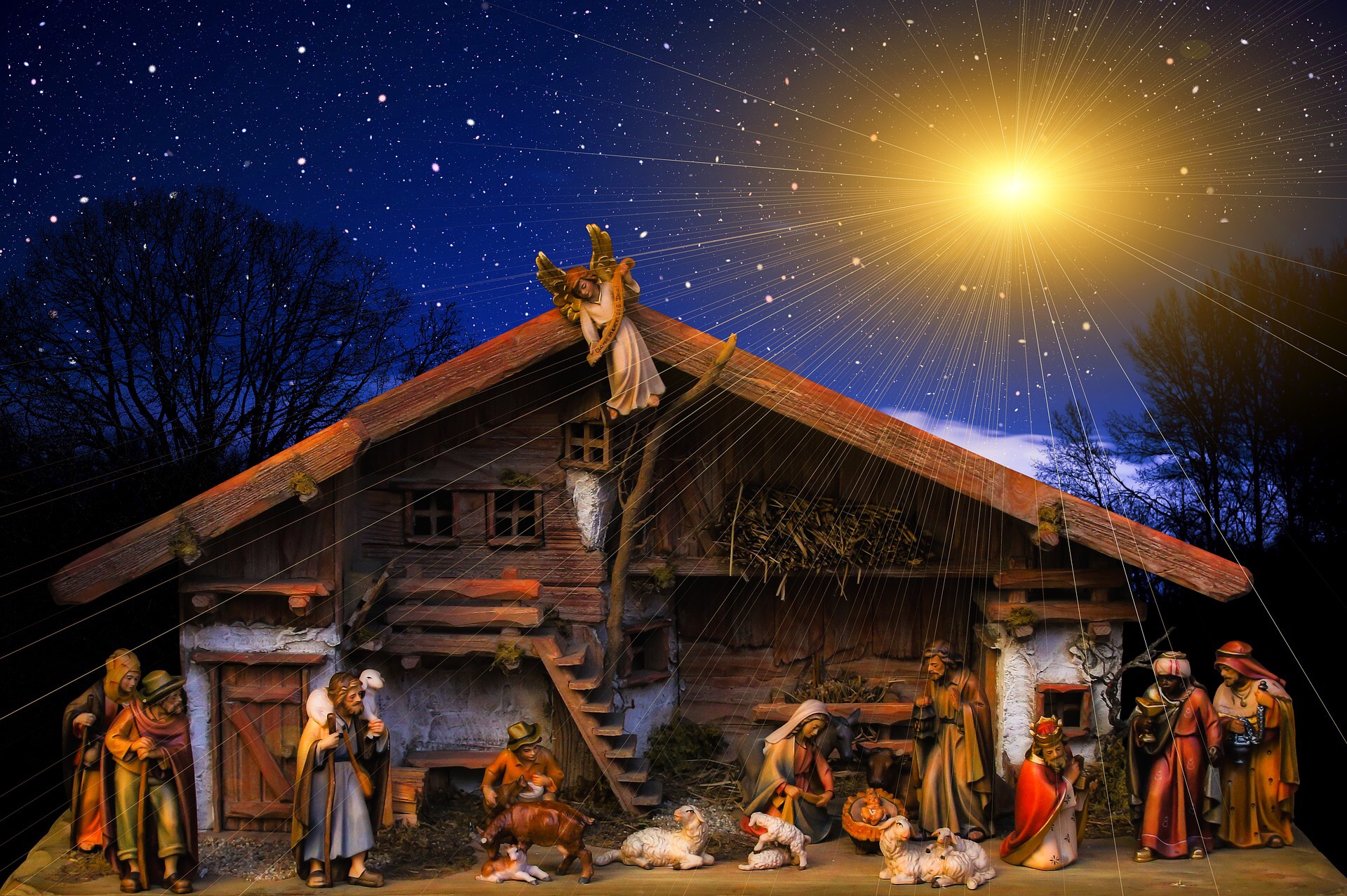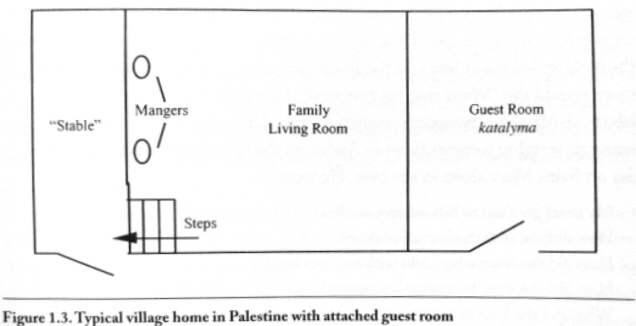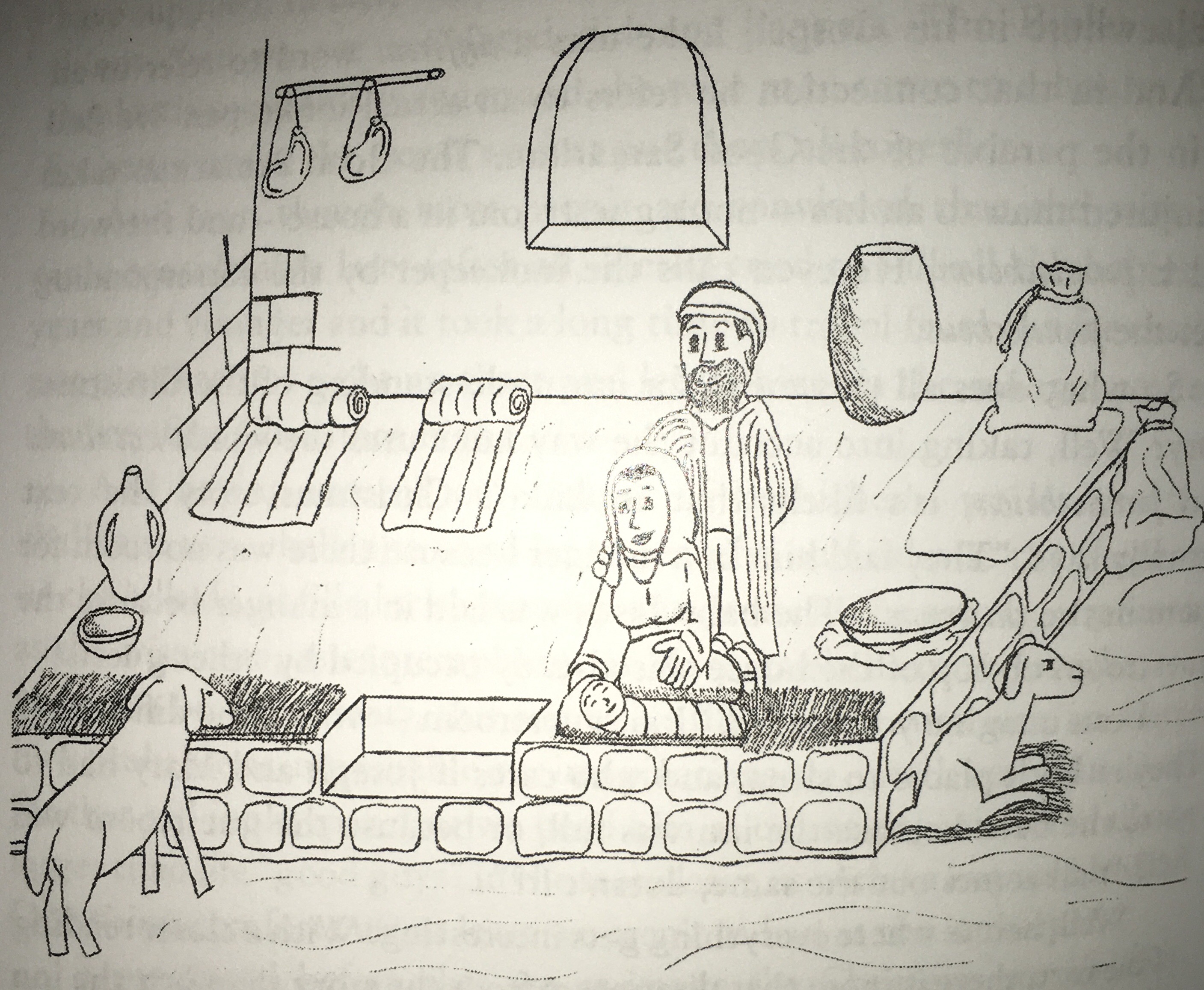What do you see when you think of the Nativity scene?
The traditional scene features the baby Jesus lying in a manger in a stable because there was no room at the inn, surrounded by Mary, Joseph, their donkey and some other animals, shepherds and their sheep, three kings bearing three gifts, a star above the stable, and angels filling the sky. Perhaps something like this:
 Source: see reference 1
Source: see reference 1
This is a composite picture drawn from the Bible… or is it?
In the description in the gospels of the scene of Jesus, there is:
- No Inn – “no room for them in the inn” is better translated “no room for them in the guest room”. “Guest room” is a more accurate translation of the Greek word kataluma in Luke 2:7. Homes at that time often had a guest room, which typically was a small room build above or to the rear of the main, combined, living and sleeping area. Given the culture, it is unthinkable that Joseph would have stayed in an inn when he had relatives in his home town. But there was “no room in the guest room” – perhaps because it was already occupied by other relatives that arrived during the census – or, more likely, because there wasn’t enough room in the guest quarters to accommodate an imminent delivery.
 Source: see reference 2
Source: see reference 2
- No stable – there is no mention of a stable. Luke’s account states that Mary placed Jesus in the manager. A “manger”, of course, refers to a feeding trough of sorts for animals. But managers were found in houses of that time and place, as domestic animals were brought into the lowest level of the home in the evenings for safety. The main living area was slightly raised from this entry level, and the manger would often be simply a depression in the floor of the main living area, which animals could access from where they were. So I see the baby Jesus lying in a manger, yes – not in a stable – but in a family home.
 Source: see reference 3
Source: see reference 3
- No donkey – no mention of a donkey. It’s an assumption that this is how a pregnant Mary would have had to travel. This could be correct, but there were other options, some safer and more comfortable.
- No animals – no mention of animals, though any animals belonging to the household may – following the arrival of the newborn – have been brought into the home for the evening.
- No kings – magi (wise men, astrologers, astronomers), but not kings. And that there were three is an assumption based on there being three gifts.
- No star – the magi that followed the star to Jesus arrived AFTER Jesus’ birth, up to, but no more than, two years later – hence Herod tragically ordering the killing of all boys, in Bethlehem, aged two years and under (Matthew 2:16). And certainly no star or magi at a stable, as Matthew 2:11 states that “On coming to the HOUSE, they [the Magi] saw the child with his mother Mary, and they bowed down and worshiped him.”
- No angels – the angels appeared to the shepherds tending their flocks in the fields on the outskirts of Bethlehem.
- No wintertime – no time is explicitly specified in the Biblical texts. However, based on when shepherds would be “watching their flocks at night” (Luke 2:8) – i.e. Spring through to October – Luke’s account of Elizabeth and Mary’s pregnancies, a case can be made for Jesus being born mid to late September, in the Jewish month of Tishrei (- see this article for more info: http://www.bibleinfo.com/en/questions/when-was-jesus-born).
_______________
What a different Christmas scene we have. Jesus born in a home, almost just like any other baby in Israel, with mother and baby tended by Joseph’s female relatives. But with a surprise visit from shepherds a short time after the birth.
William Thomson – a Presbyterian missionary to Lebanon, Syria and Palestine – wrote in 1857:
“It is my impression that the birth actually took place in an ordinary house of some common peasant, and that the baby was laid in one of the mangers, such as are still found in the dwellings of farmers in this region.”
Does it diminish the meaning at all? Not to me. It makes more sense to me to read the text again without the clutter of all the other elements. There’s a power in the simplicity and ordinariness of it all. If it wasn’t for the shepherds, perhaps no one except Joseph and Mary would have known. (Luke 2:1-20)
This new scene, as I now come to see it, resonates more readily and more deeply with me – because, for me, it is a better reflection of the Biblical account. And in that context, as the following to quotes state, it brings Jesus nearer still to our everyday lives.
New Testament scholar and Anglican cleric, the late Richard France, wrote:
“The problem with the stable is that it distances Jesus from the rest of us. It puts even his birth in a unique setting, in some ways as remote from life as if he had been born in Caesar’s Palace. [But] the message of the incarnation is that Jesus is one of us. He came to be what we are, and it fits well with that theology that his birth in fact took place in a normal, crowded, warm, welcoming Palestinian home, just like many another Jewish boy of his time.”
Professor of New Testament, Dr Tim Geddert, suggested that:
“A new reading of the text… challenges us to open our own living rooms for Jesus, making room for him not in the barn… [or] once or twice Church Services or maybe Christmas Eve and Christmas morning… but in our living rooms, right where the family lives, where the pets roam, where we work and sleep and play and eat – even when our homes are packed full of guests. … After all, they called him Emmanuel, God with us.”
Emmanuel, God with us.
One more reflection: This ordinary scene in an ordinary home in Bethlehem is interrupted somewhat by the arrival of the shepherds that same day to find “a baby wrapped in cloths and lying in a manger” (see footnote) – which, according to an angel that appeared to them whilst tending their flocks at night, was a “sign” for the shepherds in finding the “Saviour”, “Christ the Lord”, who who was born that day in Bethlehem, “the town of David”, (Luke 2:11).
What is interesting to me is that, by divine providence, the circumstances of his birth meant that Jesus:
- The promised Messiah who would sit on David’s throne was born in the town of David.
- The Bread of Life was born in Bethlehem, which means House of Bread.
- The Lamb of God who takes away the sin of the world was born in a town known for providing sheep for sacrifice in the Temple in the neighbouring city of Jerusalem.
So what do you see when you think of the Nativity of Jesus? Does it matter? And does it make a difference for you?
_______________
To conclude, to help us reflect on the meaning of the Christmas event, here are the words of the angels to Mary, to Joseph and to the shepherds announcing the nativity of Jesus:
“Do not be afraid, Mary… You will be with child and give birth to a son, and you are to give him the name Jesus. He will be great and will be called the Son of the Most High. The Lord God will give him the throne of his father David, and he will reign over the house of Jacob forever; his kingdom will never end… The Holy Spirit will come upon you, and the power of the Most High will overshadow you. So the holy one to be born will be called the Son of God.” (Luke 1:30-33,35)
“Joseph son of David, do not be afraid to take Mary home as your wife, because what is conceived in her is from the Holy Spirit. She will give birth to a son, and you are to give him the name Jesus, because he will save his people from their sins.” (Matt. 1:20-21)
[To the shepherds:] “Do not be afraid. I bring you good news of great joy that will be for all the people. Today in the town of David a Savior has been born to you; he is Christ the Lord. … Glory to God in the highest, and on earth peace to men on whom his favor rests.” (Luke 2:10-11,14)
_______________
Footnote:
The angel said to the shepherds that “This will be a sign to you: You will find a baby wrapped in cloths and lying in a manger.” (Luke 2:12)
In what way was it a sign? Was it so unusual to find a baby in a manger, and therefore it would be evident that among “all” the newborn babies in Bethlehem, this was the one? Or did a “sign” signify something else.
I asked Professor of New Testament, Dr Tim Geddert, about this. This was his reply:
‘Concerning the shepherds finding the baby, based on the angels “clues” . . . Yes, given the population of Bethlehem it would be quite UNLIKELY that two babies would be born in the same week, perhaps in the same month. Some have calculated that Herod’s murder of the Bethlehem babies could have killed about 20 babies. If that is anywhere close to correct, that is about 1 a month. On the other hand “sign” does not really have to mean “clue to help solve a puzzle”. It can be a “sign” like, for example “the sign of Jonah” and other “signs” in Scripture (miracles in John, etc.) that are not so much clues for a puzzle, but pointers to meaning.’
If the “sign” of the “manger” was a pointer to a deeper meaning, perhaps it alludes to Isaiah 1:3 – “The ox knows his master, the donkey his owner’s [master’s; Lord’s] manger, but Israel does not know, my people do not understand.”
Perhaps there was an ox and a donkey beside the manager after all!
_______________
References:
- Photo sourced at: https://pixabay.com/photo-2874137/
- Rev. Ian Paul (2017) “Jesus was not born in a stable (honest!)”. (Blog post) See: https://www.psephizo.com/biblical-studies/jesus-was-not-born-in-a-stable-honest.
- Timothy J. Geddert (2007) “Enriching our Christmas Traditions”, a chapter from the His book “Double Take: New Meanings From Old Stories”.
Tags: Birth of Christ, Birth of Jesus, Christmas, Nativity, New Testament
Leave a comment